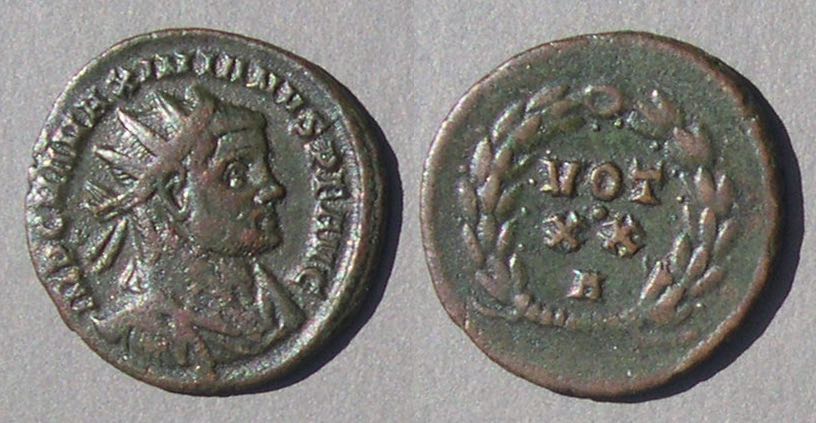 The "radiate fraction" denomination, a.k.a. the "post-reform radiate."
The "radiate fraction" denomination, a.k.a. the "post-reform radiate."
Diocletian's coin reform of c. 294 introduced two new base-metal denominations, the very common large "follis" (a.k.a. "nummus") and the smaller "radiate fraction," also known as a "post-reform radiate." The first radiate fractions looked very much like the previous aurelianus (a.k.a. antoninianus). The size was the same and the radiate head was similar, so they can be hard to tell apart. (How to tell them apart is discussed here.)
What's new? 2024, Oct 17: Images for all coins enlarged.
2023, April 6: Severus II as Caesar
2022, Feb. 9: 2020, CONCORDIAE AVGG.
2021 Oct. 21: Maximian from Cyzicus.
2021, Oct. 14: Diocletian pieces from Cyzicus and Antioch. Galerius from Cyzicus.
Radiate fractions are much less common than folles and aureliani, but are not more expensive because there is little demand and there are enough of them to satisfy it. There are only four types.
- VOT XX in wreath for the Augusti. From Carthage, Rome, and Ticinum (Maximian, from Rome, to the upper right and below)
- VOT X in wreath for the Caesars. From Carthage and Ticinum.
-
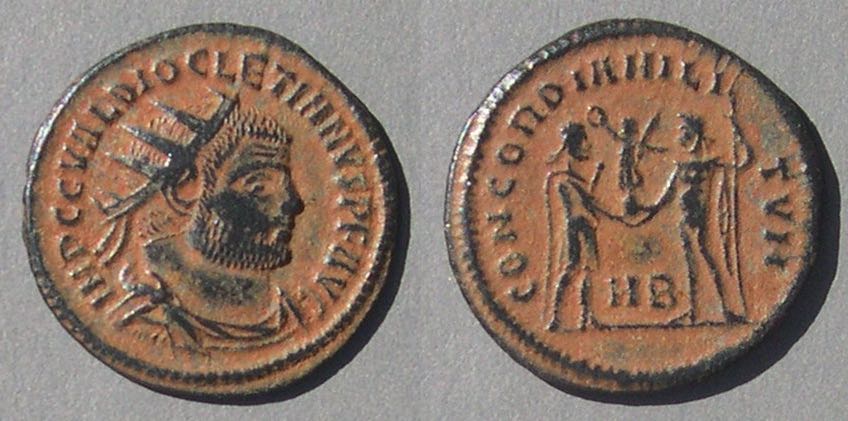 CONCORDIA MILITVM with Jupiter on right presenting Victory on globe to the emperor. From Heraclea, Cyzicus, Antioch, and Alexandria. It is common. (Diocletian on the second coin, from Heraclea.)
CONCORDIA MILITVM with Jupiter on right presenting Victory on globe to the emperor. From Heraclea, Cyzicus, Antioch, and Alexandria. It is common. (Diocletian on the second coin, from Heraclea.)
- CONCORDIAE AVGG with the same design, from Ticinum ("c. 294-5") and Rome ("c. 294-5" and "c. 296-7") for all four tetrarchs. It is very rare.
The most common type, CONCORDIA MILITVM (to the right for Diocletian, and below) is dated by RIC to c. 295-7. The author of RIC selected those dates because the denomination was part of the coin reform which began c. 294, probably with the follis denomination being introduced first. We don't know when they got around to adding in this denomination. Presumably the supply of old radiates sufficed at first for lower-denomination coins.
It is not certain how the reform pegged its values of the denominations. Some, but not all, authors think these new radiates were 2 denarii both before and after Diocletian's Edict of Maximum prices (while the value of the follis doubled [to 20 or 25?] and the argenteus became 100 denarii). Where did the old aurelianus fit in? I think it was also originally pegged at 2 denarii which explains seven things. The radiate fraction
- looks a lot like the aurelianus
- was initiated to save money (silver) by not including silver, but pegged as equal to the previous denomination which had some silver
- made it unnecessary to mint the radiate fraction because so many aureliani were still around, so some mints didn't mint it
- it is most common from Alexandria because only that region did not have a pre-existing supply of a denomination lower than the follis. Their coinage prior to the reform consisted of Alexandrian tetradrachms which were discontinued. The lower-denomination aureliani common everywhere else were not legal tender in Egypt and did not circulate there.
- made the new radiate fraction unpopular because the old aurelianus was worth more, intrinsically, so it
- didn't last long in the coinage system and went out of production everywhere by c. 297-8 (unless you agree with RIC that the vota types were issued c. 303. I think they were issued from the beginning of the denomination, c. 296), until the denomination was revived for the Second Tetrarchy at Alexandria c. 305
- it was revived after 305 only at Alexandria because only Egypt did not have a pre-existing large supply of coins of lower denomination than the follis
Of the fifteen active mints, eight did not issue the radiate fraction. Seven did: Ticinum (none here), Rome, Carthage, Heraclea, Cyzicus, Antioch, and Alexandria. Most examples are from Alexandria, Egypt, which accepted this low-quality coin more readily than other regions because they had no other denomination of lower value than the follis. Also, Alexandria was the only mint to issue the denomination after Diocletian's Edict on Maximum Prices of 301. Some pieces belong to the Second Tetrarchy and some even later, until 307 (Severus II as Augustus).
(Links are to paragraphs further down the page.)
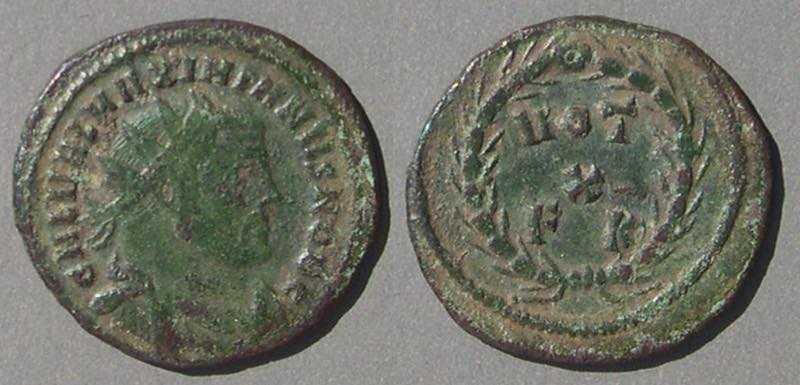 The first two VOT types are dated in RIC VI to "c. 303" (i.e. at the beginning of Diocletian's twentieth year), but I'm doubtful. Why would these mints not issue the denomination promptly at the same time it was begun elsewhere? Are we supposed to think they waited six years before issuing the denomination? Also, vows on coins are usually vows taken (suscepta) for the next ten years (see a page on vows here). Vows for ten years are usually at the beginning of the reign and vows for twenty after ten years when the original vows are renewed for twenty. The vow-number XX would be normal after nine or ten years of reign for Augusti (or, the senior Augustus, Diocletian) and vow-number X for the vows at the beginning of the reign of the Caesars, that is, closer to 294-5 and the coin reform than to 303 (Galerius as Caesar, the third coin and here). So these ought to be as soon as the reform occurred and this denomination appeared. Then there would be no long gap between when they appear elsewhere and when they appear at Carthage. At Carthage, the obverse legend for Maximian (it was in his territory) is IMP C M A MAXIMIANVS PF AVG (Here). That is a long legend typical of earlier in his reign. Why would Carthage bring the denomination back after other mints had long abandoned it? Even Alexandria, the mint where it was most common, gives no evidence of minting radiate fractions in the interval after c. 296-297 until the Second Tetrarchy began in May 305. In my opinion, the Carthage radiate fractions should be dated just like the others, to c. 296-297, that is, as soon as the Carthage mint was opened after the denomination was added to the coinage. The few radiate fractions from Alexandria after July 305 (for the Second Tetrarchy and then for Severus II as Augustus and Constantine as Caesar) stand alone in time and mint.
The first two VOT types are dated in RIC VI to "c. 303" (i.e. at the beginning of Diocletian's twentieth year), but I'm doubtful. Why would these mints not issue the denomination promptly at the same time it was begun elsewhere? Are we supposed to think they waited six years before issuing the denomination? Also, vows on coins are usually vows taken (suscepta) for the next ten years (see a page on vows here). Vows for ten years are usually at the beginning of the reign and vows for twenty after ten years when the original vows are renewed for twenty. The vow-number XX would be normal after nine or ten years of reign for Augusti (or, the senior Augustus, Diocletian) and vow-number X for the vows at the beginning of the reign of the Caesars, that is, closer to 294-5 and the coin reform than to 303 (Galerius as Caesar, the third coin and here). So these ought to be as soon as the reform occurred and this denomination appeared. Then there would be no long gap between when they appear elsewhere and when they appear at Carthage. At Carthage, the obverse legend for Maximian (it was in his territory) is IMP C M A MAXIMIANVS PF AVG (Here). That is a long legend typical of earlier in his reign. Why would Carthage bring the denomination back after other mints had long abandoned it? Even Alexandria, the mint where it was most common, gives no evidence of minting radiate fractions in the interval after c. 296-297 until the Second Tetrarchy began in May 305. In my opinion, the Carthage radiate fractions should be dated just like the others, to c. 296-297, that is, as soon as the Carthage mint was opened after the denomination was added to the coinage. The few radiate fractions from Alexandria after July 305 (for the Second Tetrarchy and then for Severus II as Augustus and Constantine as Caesar) stand alone in time and mint.
Alexandria. The greatest selection of rulers and the examples that are easiest to find are from Alexandria:

Diocletian
21 mm. 3.21 grams.
IMP C C VAL DIOCLETIANVS PF AVG
Γ
ALE
RIC Alexandria 46a "c. 296-7"
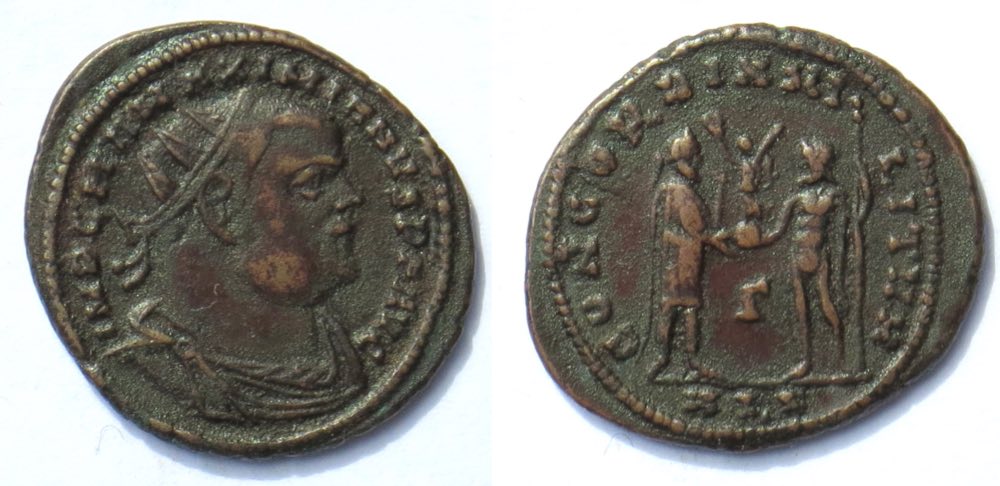 Maximian
Maximian
22-20 mm. 3.64 grams.
IMP C MA MAXIMIANVS PF AVG
Γ
ALE
RIC Alexandria 46b "c. 296-7"
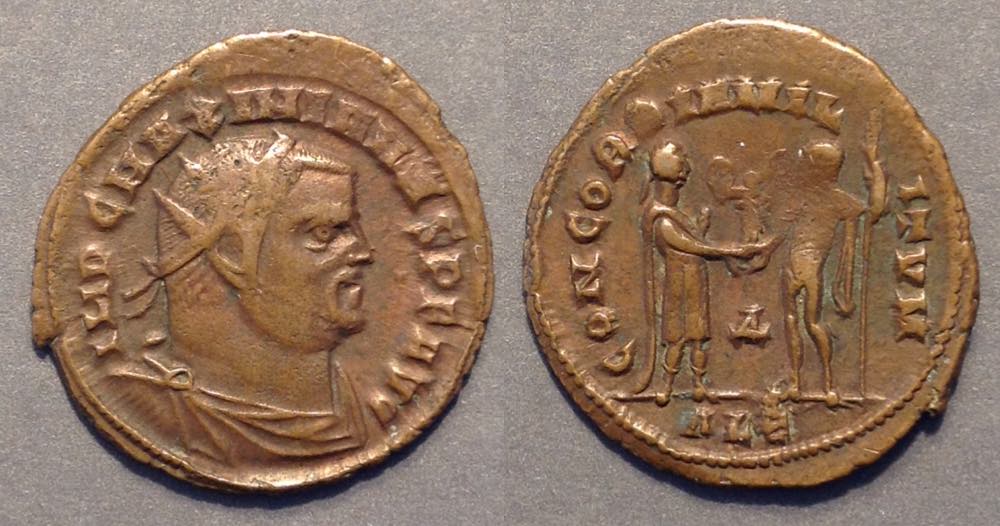 Galerius as Augustus (Second Tetrarchy)
Galerius as Augustus (Second Tetrarchy)
22 mm. 2.75 grams.
IMP C MAXIMIANVS PF AVG
Δ
ALE
RIC VI Alexandria 59b "305-306"
Sear IV 14531
[Compare to the previous coin.]
They are so similar it raises questions about their dates, supposedly nine years apart. The Galerius as Augustus must be from after May 1, 305 because Constantius as Augustus and Severus II as Caesar are in the issue (which make it a Second Tetrarchy issue). It does not look like a portrait of Maximian, which it would if it were First Tetrarchy. Must we agree with RIC that this denomination was issued for a couple of years, discontinued, and then resumed eight years later with no change of control marks?
(Later issues from Alexandria are below.)
Carthage. Carthage had VOT XX for the Augusti and VOT X for the Caesars.
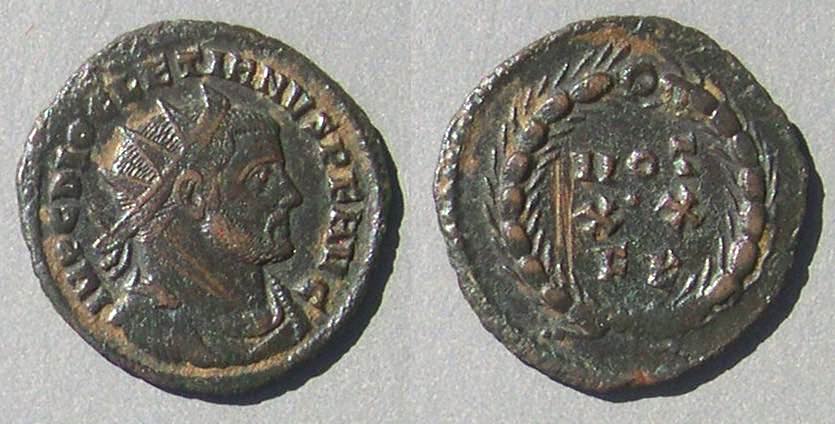 Diocletian
Diocletian
21 mm. 2.86 grams.
IMP C DIOCLETIANVS PF AVG
VOT
X•X
FK (Felix Karthage)
in wreath
RIC Carthage 37a "c. 303" [but, see above for a different date]
 Maximian
Maximian
23 mm. 3.23 grams
IMP C MAXIMIANVS PF AVG
VOT
X X
FK (Felix Karthage)
RIC Carthage 37b "c. 303" [but, see above for a different date]
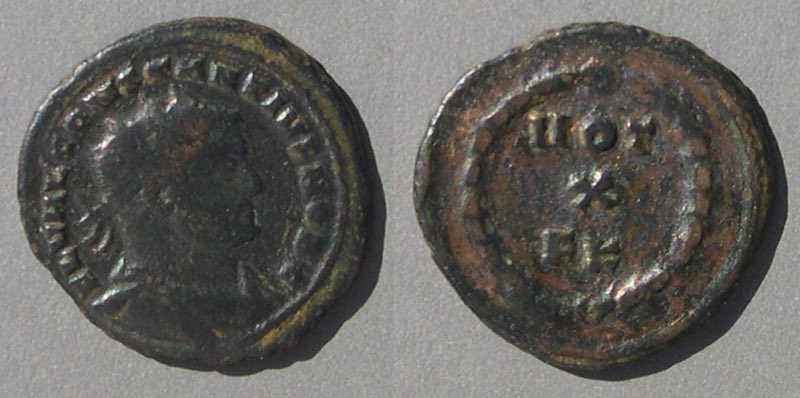 Constantius as Caesar
Constantius as Caesar
23 mm. 3.88 grams.
VOT
X
FK
RIC Carthage 35a "c. 303" [but, see above for a different date]
 Galerius as Caesar
Galerius as Caesar
22 mm. 3.55 grams.
GAL VAL MAXIMIANVS NOB C
VOT
X
F K
This example has his own vow-number.
RIC Carthage 35b "c. 303" (But see the alternative date above.)
Rome. Rome has the rare CONCORDIAE AVGG type (which is not illustrated here) and the two types of Carthage. The difference is in the letter(s) below the vow-number. Carthage has "K" and an officina number in Greek. Rome has just the officina number in Greek.
 Maximian [repeated from above]
Maximian [repeated from above]
21 mm. 3.29 grams.
IMP C M A MAXIMIANVS PF AVG
VOT
X•X
A
RIC Rome 75, "c. 297-8"
 Constantius as Caesar, with vow-number appropriate for the Augusti.
Constantius as Caesar, with vow-number appropriate for the Augusti.
FL VAL CONSTANTIVS NOB C
VOT
X•X
Γ
RIC Rome 87a "c. 297-8"
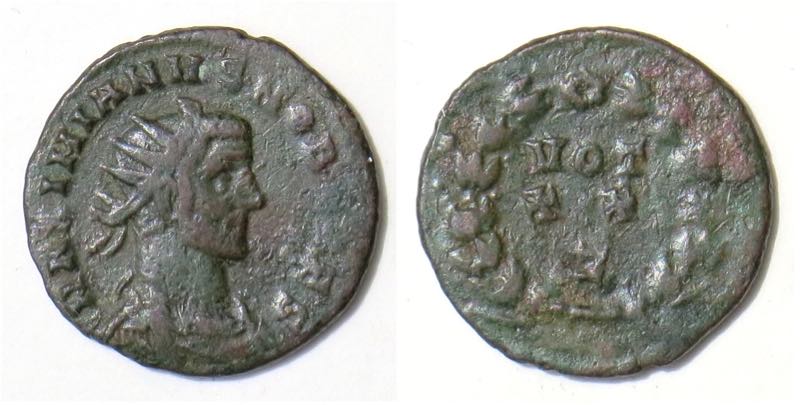
Galerius as Caesar, with vow-number appropriate for the Augusti.
20 mm. 3.18 grams
MAXIMIANVS NOB CAES
VOT
X X
[?] possibly Z (would be 7, numbers went up to 9)
RIC Rome 88b "c. 297-8"
Heraclea. The Heraclea mintmark was a "H" in the middle field for "Heraclea," with an officina number in Greek.
 Diocletian
Diocletian
21 mm. 2.78 grams.
IMP C C VAL DIOCLETIANVS PF AVG
HB
RIC Heraclea 13
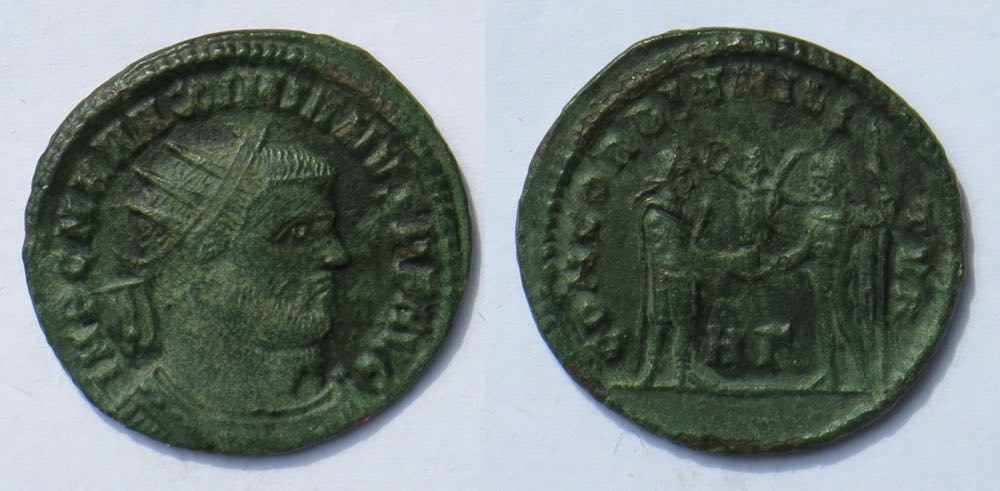 Maximian
Maximian
21 mm. 2.67 grams.
IMP C M A MAXIMIANVS PF AVG
HΓ
RIC Heraclea 14
RIC notes [p. 522] that, at Heraclea, the western rulers are radiate and cuirassed without drapery, but the eastern rulers are also draped (as Diocletian above).
Cyzicus. The Cyzicus mintmark used a "K" in the middle field for "Kyzikos," with an officina number in Greek.
 Diocletian
Diocletian
21-19 mm. 2.87 grams.
IMP C C VAL DIOCLETIANVS PF AVG
Radiate and cuirassed bust right
KΓ
RIC Cyzicus 15a
Sear IV 12834
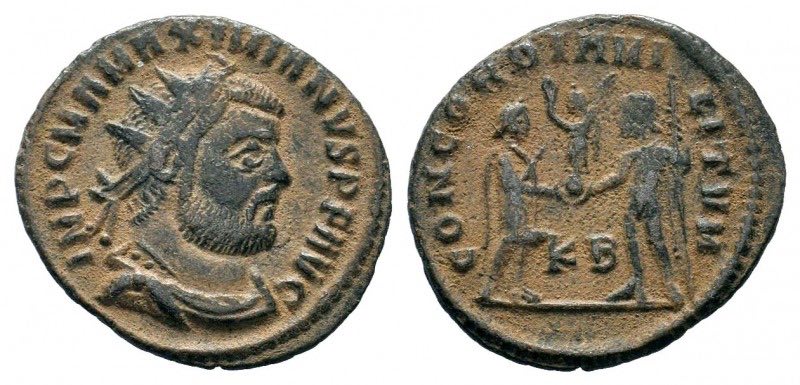 Maximian
Maximian
22-20 mm. 3.12 grams.
IMP C MA MAXIMIANVS PF AVG
Radiate, draped, and cuirassed bust right.
KB
RIC Cyzicus 15b "c. 295-9"
Sear IV 13315
 Constantius as Caesar
Constantius as Caesar
20-19 mm.
FL VAL CONSTANTIVS NOB CAES
KB
RIC Cyzicus 18a "c.295-9"
Sear IV 14104
 Galerius as Caesar
Galerius as Caesar
21 mm. 3.15 grams.
GAL VAL MAXIMIANVS NOB CAES
KA
RIC Cyzicus 19b "c. 295-9"
Antioch. Antioch used the mintmark ANT in exergue, with symbols including the officina number (1-7) in Greek in the middle field.
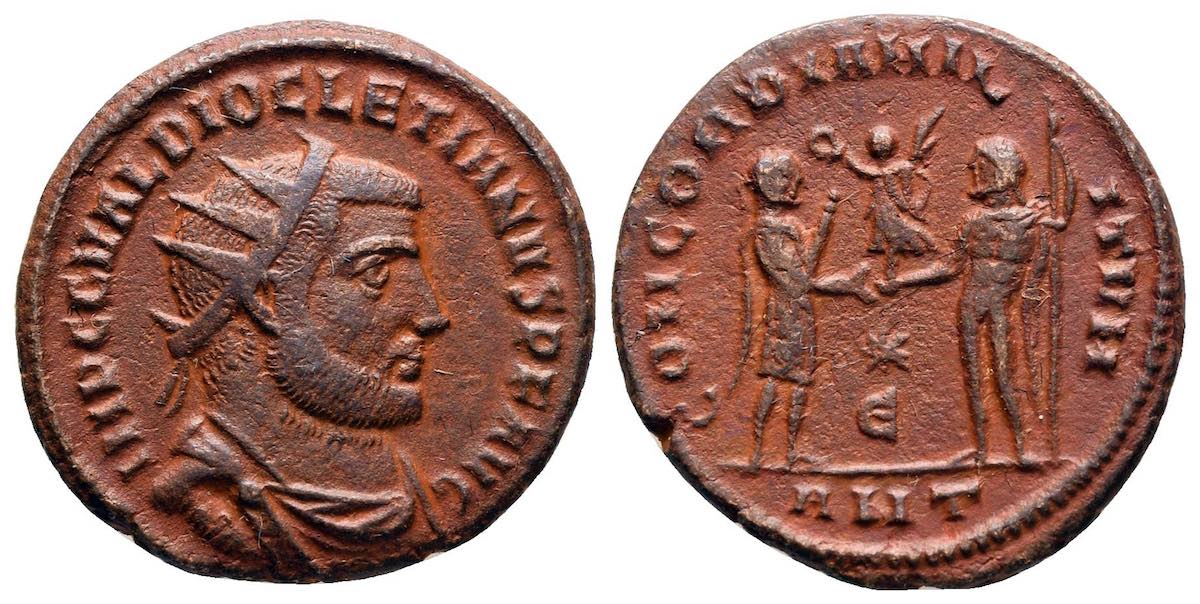 Diocletian
Diocletian
20-19 mm. 3.25 grams.
IMP C C VAL DIOCLETIANVS PF AVG
*
Є
ANT
RIC Antioch 60a "c. 296"
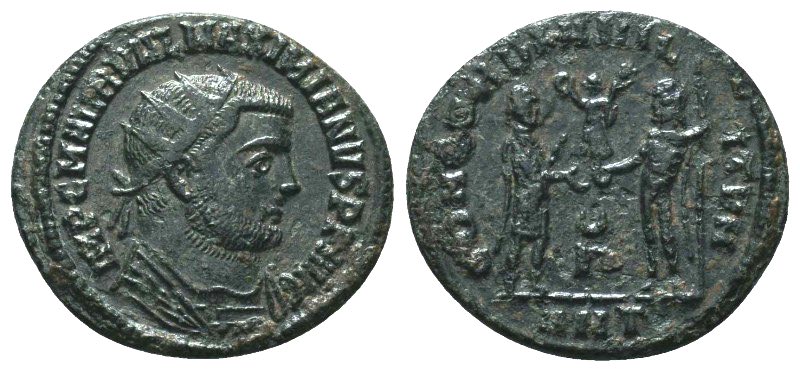 Maximian
Maximian
20 mm. 2.70 grams. A "radiate fraction."
IMP C M AVR VAL MAXIMIANVS PF AVG.
Marcus AVRelius VALerius Maximianus
The long version of his name on a radiate fraction minted at Antioch.
Most of his legends are much more abbreviated.
<crescent>
Γ
ANT
RIC VI Antioch 60b "c. 296"
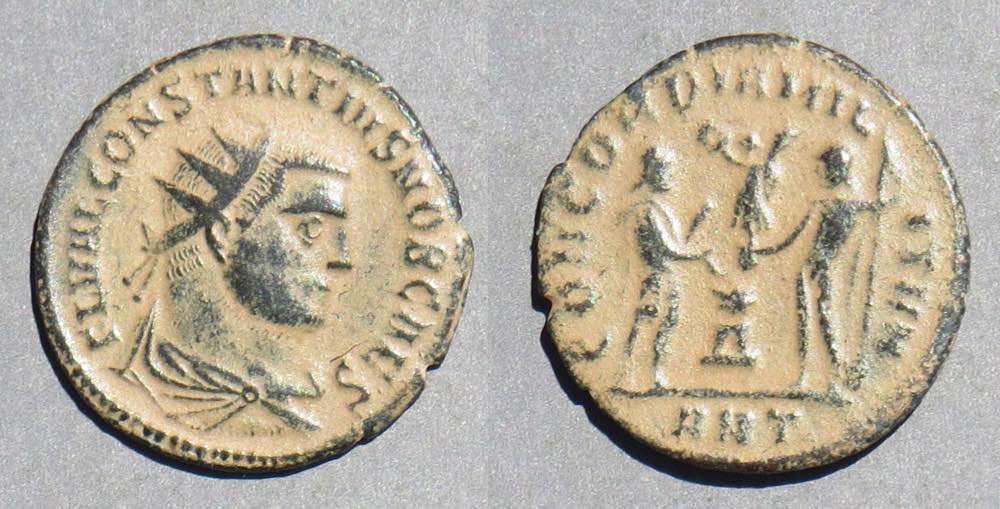 Constantius as Caesar
Constantius as Caesar
19 mm. 2.68 grams.
FL VAL CONSTANTIVS NOB CAES
*
Δ
ANT
RIC Antioch 61a "c. 296"
The radiate fraction revived. Apparently radiate fractions were only issued for two or three years and then died out. However, the denomination was revived for a short while at Alexandria, Egypt, which minted it for the Second Tetrarchy (Galerius and Constantius as Augusti and Severus II and Maximinus II as Caesars) and then for Severus II as Augustus (306-307) and Constantine as Caesar (306-307).

Constantius as Augustus (Second Tetrarchy, 305-306)
21-19 mm. 3.12 grams.
IMP C CONSTANTIVS PF AVG
B
ALE
RIC Alexandria 59a
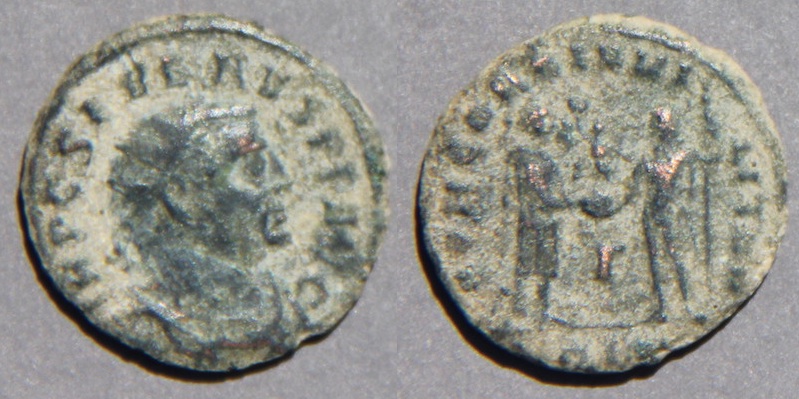
Severus II as Augustus (after the Second Tetrarchy)
21-20 mm. 3.68 grams.
IMP C SEVERVS PF AVG
Γ
ALE
RIC VI Alexandria 84 "306-early 307"Sear IV 14682
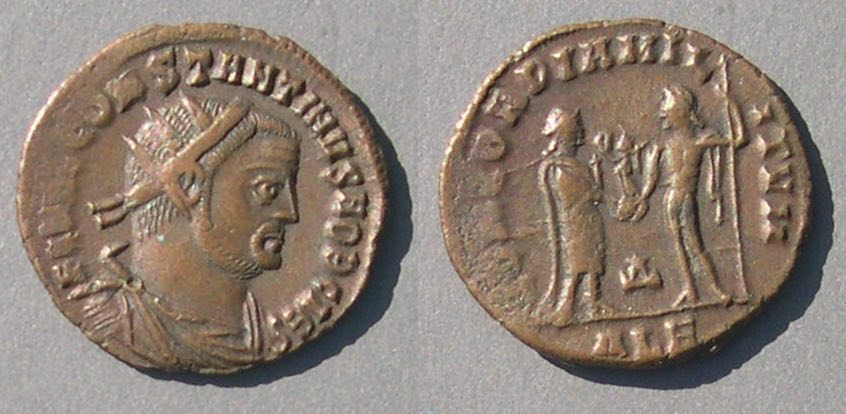 Constantine as Caesar, July 306-July 307 (after the Second Tetrarchy)
Constantine as Caesar, July 306-July 307 (after the Second Tetrarchy)
20 mm.
FL VAL CONSTANTINVS NOB CAES
(The portrait is not at all like the portrait from western mints that knew what Constantine looked like.)
Δ
ALE
RIC Alexandria 85 "306 - early 307"
CONCORDIAE AVGG
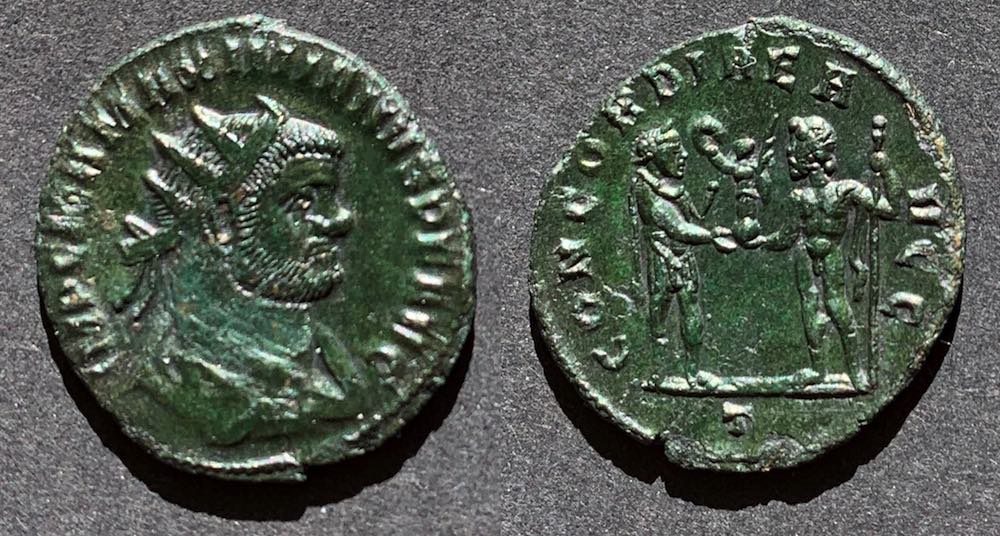 Maximian
Maximian
21 mm. 3.14 grams.
IMP C MA MAXIMIANVS PF AVG
CONCORDIAE AVGG
T in exergue
with the same design as the other radiate fractions.
RIC Ticinum 25b "c. 294-5"
RIC has this type from Ticinum as "scarce" for all four tetrarchs. I think "very rare" is closer to correct.
Image courtesy of Wolfram Tillack.
The CONCORDIAE AVGG type is also listed at Rome and one from Siscia is recorded. It is extremely rare from any mint other than Ticinum.
The end. Return to the top of this page.
Go to the page, "Introduction to Roman Coins of the First Tetrarchy."
Go to the page "Roman Coins of the Second Tetrarchy."
There is a page of links to pages on coins of the tetrarchies. A table of radiate fractions.
Go to the Table of Contents for this whole educational site.
 The "radiate fraction" denomination, a.k.a. the "post-reform radiate."
The "radiate fraction" denomination, a.k.a. the "post-reform radiate." CONCORDIA MILITVM with Jupiter on right presenting Victory on globe to the emperor. From
CONCORDIA MILITVM with Jupiter on right presenting Victory on globe to the emperor. From 

 Maximian
Maximian Galerius as Augustus (Second Tetrarchy)
Galerius as Augustus (Second Tetrarchy) Diocletian
Diocletian Maximian
Maximian Constantius as Caesar
Constantius as Caesar Constantius as Caesar, with vow-number appropriate for the Augusti.
Constantius as Caesar, with vow-number appropriate for the Augusti.
 Maximian
Maximian 

 Constantius as Caesar
Constantius as Caesar Galerius as Caesar
Galerius as Caesar Diocletian
Diocletian Maximian
Maximian Constantius as Caesar
Constantius as Caesar 
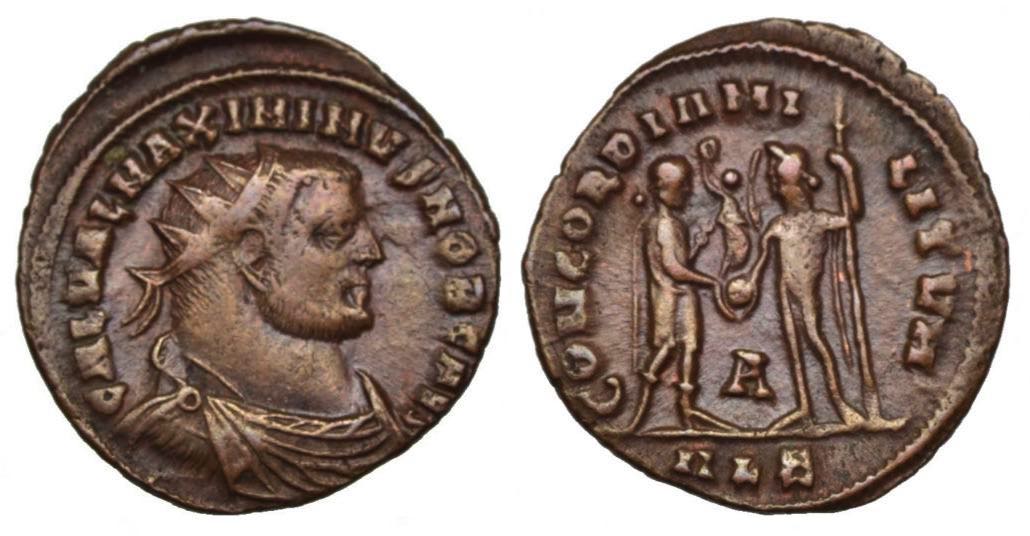 Maximinus II as Caesar
Maximinus II as Caesar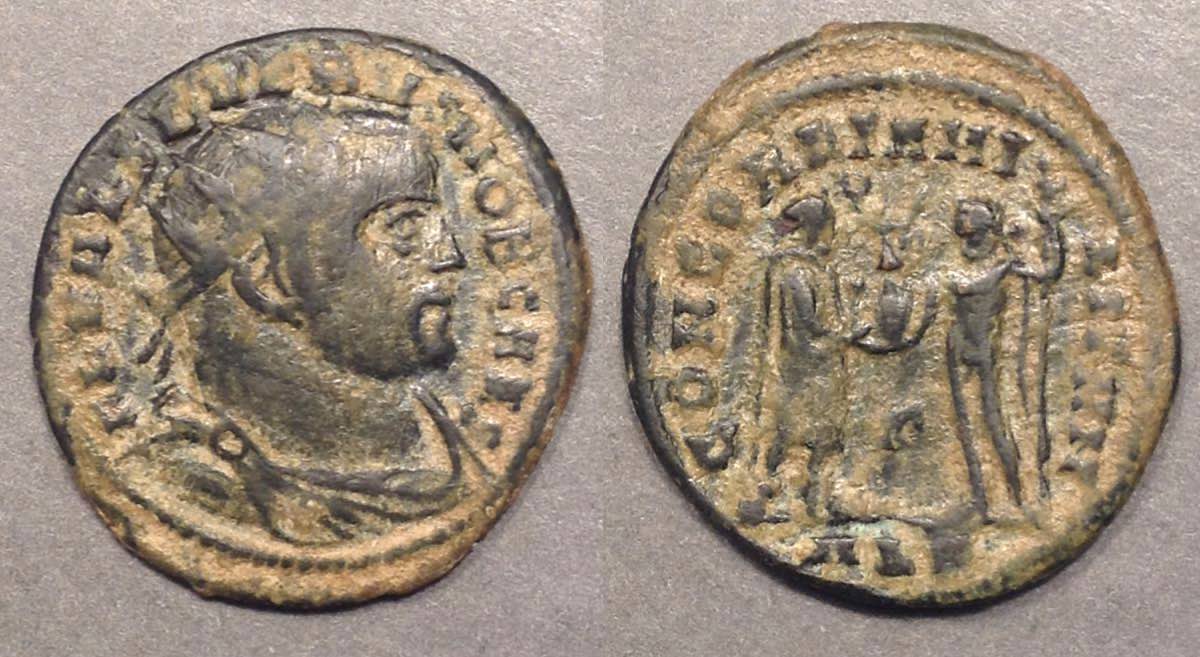 Severus II as Caesar (of the Second Tetrarchy)
Severus II as Caesar (of the Second Tetrarchy)
 Constantine as Caesar, July 306-July 307 (after the Second Tetrarchy)
Constantine as Caesar, July 306-July 307 (after the Second Tetrarchy) Maximian
Maximian